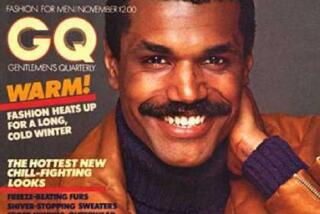Fashion as one piece of the puzzle
- Share via
Less than three weeks ago, designer and author Alan Flusser was toasting Art Cooper -- the outgoing GQ magazine editor -- at his retirement party. Ralph Lauren was among the 400 guests. So was Donna Karan. Mel Brooks too. And before the fete ended, Cooper and his wife, Amy, a former magazine editor herself, were given a trip around the world.
“He was lionized by his staff and friends,” Flusser recalls of Cooper, who died Monday in New York after suffering a stroke days earlier. “That was barely 2 1/2 weeks ago. We’re all in shock. Soon we will all be attending his funeral. But the man will not be forgotten. He epitomized the phrase, ‘He’s so GQ.’ ”
Many in the fashion industry hailed Cooper as a man who knew how to combine style and masculinity, and helped teach American men that it was OK to embrace both.
Cooper loved clothes and that, says Flusser, is unusual for editor types. “A lot of people at his level are more businesslike. But Art had a feel for clothes. He made the name GQ synonymous with the fashionable man. He turned those initials into an adjective. He raised the consciousness of what it meant for a man to be fashionable.”
In fact, Cooper and Flusser hatched “a favorite idea,” says Flusser. “I would gather all the dandies of the world in New York and Art would photograph it. We often talked about doing that.”
A friend of Cooper’s since the early 1980s, Flusser will always remember the man for his warmth and support. Flusser credits Cooper with introducing him to Random House editors. The imprint later published Flusser’s next book (“Clothes and the Man”), which Cooper then excerpted in GQ. “At least 30,000 copies of that book were sold through GQ,” he says. “That was Art’s doing. He furthered my being an author.”
Those who knew Cooper credit him with transforming GQ upon his arrival in 1983 into a magazine for all men, giving the pages less of a fashion runway emphasis and adding more political, investigative and lifestyle stories to its content.
“I think what Cooper actually did was to broaden the scope of the men’s style magazine so that it was relevant to real men and not just men who are fashion-obsessed,” says David Wolfe, menswear expert and creative director of the Doneger Group, a New York-based fashion-trend consulting firm.
“I think before Art Cooper’s time, the only men who read magazines about fashion were gay men. Before he came along, GQ was kind of a sissy magazine. He butched it up. A lot of men are interested in style because Cooper gave GQ a real brain. He realized that fashion is a small piece of the total mix in the way that it is a small part of most men’s lives. He went after the man of style, men who are more interested in style than in fashion. The thing to note here is that a man’s style encompasses more than his clothes; it also includes his intellect. That’s what Art Cooper understood.”
Patty Nast Canton, president and head designer of Nat Nast, a men’s line, agrees.
“Art Cooper had so much passion for style. He was about style and lifestyle. He integrated the two and showed men how to be elegant and masculine at the same time. He was a Frank Sinatra fan and played Sinatra music every afternoon. He was so GQ in that way,” she says.
Stan Herman, president of New York-based Council of Fashion Designers of America, will always appreciate Cooper for “his love of the men’s industry. He represented the metamorphosis of men’s fashion without making it too serious.”
“He had something to say to the average guy -- that he could have a little bit of glamour in his life -- and that became such a part of his life. Art made fashion presentable for the man in middle America. He cared,” says Herman. “And because of that he represents an end of an era.”






